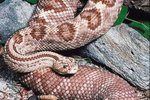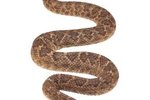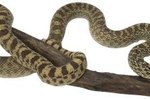
Given that 21 of the 25 most venomous snakes in the world live in Australia, it should come as no surprise that the most poisonous snake in Australia is also the most poisonous snake in the world. The inland taipan, commonly known as the “fierce snake,” has venom so powerful a single bite could kill 100 grown men. Despite its deadly venom, no human deaths from an inland taipan bite have been reported as of early 2013.
Inland Taipan Venom
An inland taipan snake’s venom contains a powerful neurotoxin that immobilizes prey by blocking the signals its nerves send to its muscles. This neurotoxin is combined with a myotoxin that eats away at muscle tissue, and a procoagulant that keeps blood from clotting and increases the rate at which the toxins are absorbed by the body. Most venomous snakes bite and then release their prey, waiting for the venom to kill the animal before they consume it. The inland taipan’s venom acts so quickly, however, that it never has to release its prey and can start consuming an animal immediately after the venomous bite is delivered.
Physical Description
The fierce snake grows to 6 or 7 feet in length. Their scales range from yellowish-brown to dark brown in color, and their heads and necks are usually a darker shade than the rest of their bodies. They change color seasonally, displaying a darker coloration in winter. This adaptation is believed to enable the cold-blooded creatures to absorb more heat in colder months. The inland taipan’s scales often have a darker edge, giving the snake’s skin a herringbone pattern.
Location and Habitat
The inland taipan lives in remote, sparsely populated areas of southwestern Queensland and northeastern South Australia. There the fierce snake eats long-haired rats. They shelter in deep cracks in the dry soil, escaping heat and predators in a desolate region with sparse vegetation. The inhospitable climate ensures few people ever encounter the inland taipan.
Behavior
Fierce snakes spend the morning hunting prey, retiring in the afternoon to rest in the shade. Herpetologists assume the inland taipan mates in late winter, and the female lays a clutch of between 11 and 20 eggs in a deep soil crevice or the abandoned burrow of another animal. They are shy, non-aggressive snakes, and if threatened will hide rather than attack. This temperament provides another reason humans are seldom bitten by inland taipans.
References
Resources
Photo Credits
-
John Foxx/Stockbyte/Getty Images
Writer Bio
Jennifer Mueller began writing and editing professionally in 1995, when she became sports editor of her university's newspaper while also writing a bi-monthly general interest column for an independent tourist publication. Mueller holds a Bachelor of Arts in political science from the University of North Carolina at Asheville and a Juris Doctor from Indiana University Maurer School of Law.




